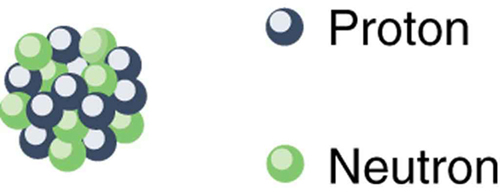| << Chapter < Page | Chapter >> Page > |
where and is the mass number of the nucleus. Note that . Since many nuclei are spherical, and the volume of a sphere is , we see that —that is, the volume of a nucleus is proportional to the number of nucleons in it. This is what would happen if you pack nucleons so closely that there is no empty space between them.

Nucleons are held together by nuclear forces and resist both being pulled apart and pushed inside one another. The volume of the nucleus is the sum of the volumes of the nucleons in it, here shown in different colors to represent protons and neutrons.
(a) Find the radius of an iron-56 nucleus. (b) Find its approximate density in , approximating the mass of to be 56 u.
Strategy and Concept
(a) Finding the radius of is a straightforward application of given . (b) To find the approximate density, we assume the nucleus is spherical (this one actually is), calculate its volume using the radius found in part (a), and then find its density from . Finally, we will need to convert density from units of to .
Solution
(a) The radius of a nucleus is given by
Substituting the values for and yields
(b) Density is defined to be , which for a sphere of radius is
Substituting known values gives
Converting to units of , we find
Discussion
(a) The radius of this medium-sized nucleus is found to be approximately 4.6 fm, and so its diameter is about 10 fm, or . In our discussion of Rutherford’s discovery of the nucleus, we noticed that it is about in diameter (which is for lighter nuclei), consistent with this result to an order of magnitude. The nucleus is much smaller in diameter than the typical atom, which has a diameter of the order of .
(b) The density found here is so large as to cause disbelief. It is consistent with earlier discussions we have had about the nucleus being very small and containing nearly all of the mass of the atom. Nuclear densities, such as found here, are about times greater than that of water, which has a density of “only” . One cubic meter of nuclear matter, such as found in a neutron star, has the same mass as a cube of water 61 km on a side.
What forces hold a nucleus together? The nucleus is very small and its protons, being positive, exert tremendous repulsive forces on one another. (The Coulomb force increases as charges get closer, since it is proportional to , even at the tiny distances found in nuclei.) The answer is that two previously unknown forces hold the nucleus together and make it into a tightly packed ball of nucleons. These forces are called the weak and strong nuclear forces . Nuclear forces are so short ranged that they fall to zero strength when nucleons are separated by only a few fm. However, like glue, they are strongly attracted when the nucleons get close to one another. The strong nuclear force is about 100 times more attractive than the repulsive EM force, easily holding the nucleons together. Nuclear forces become extremely repulsive if the nucleons get too close, making nucleons strongly resist being pushed inside one another, something like ball bearings.

Notification Switch
Would you like to follow the 'Physics 101' conversation and receive update notifications?